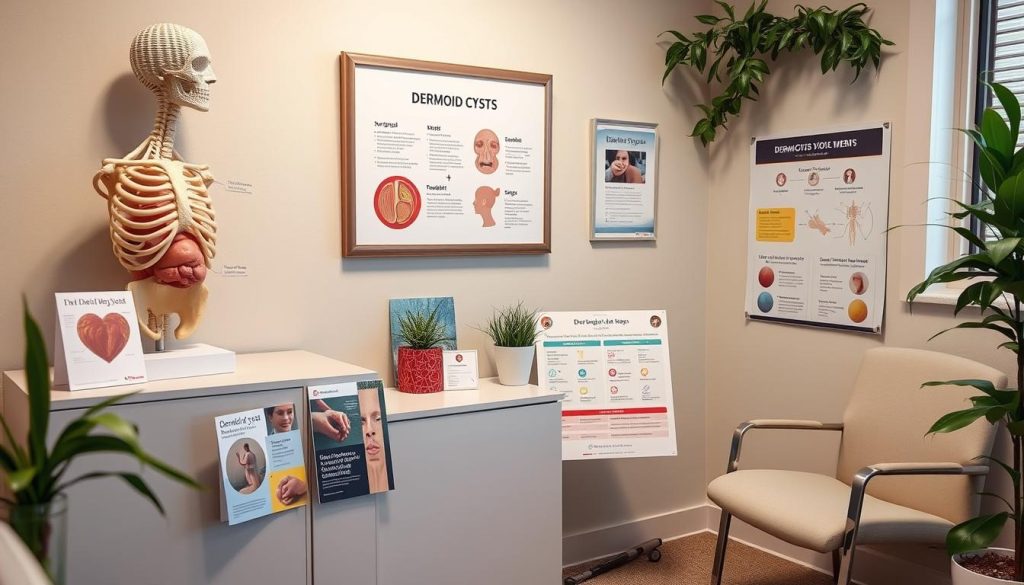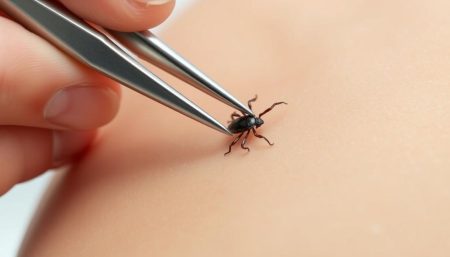Being aware of your health is key. This is true for dermoid cyst signs too. Spotting symptoms early can prevent bigger health issues. Knowing what to look for helps you take care of yourself sooner.
Understanding recognizing dermoid cysts is important. These growths might seem harmless but can cause problems if ignored. By knowing the signs, you can work with doctors to keep your health on track.
Learning about dermoid cyst symptoms is a great first step. It helps you make smart choices about your health. Let’s explore these signs together, so you can take better care of yourself.
Understanding Dermoid Cysts: An Overview
Dermoid cysts are quite puzzling but also very interesting. To diagnose them well, we need to know what they are and why they form.
What is a Dermoid Cyst?
A dermoid cyst is a type of benign tumor. It’s usually covered and can have hair, skin, and even teeth or bones inside. These cysts are mostly present at birth and come from the skin layer that develops during pregnancy.
The Biology Behind Dermoid Cysts
Dermoid cysts form when skin gets trapped during pregnancy. This makes them very complex to diagnose. Studying them helps doctors understand why they happen and how to treat them.
Dermoid Cyst Symptoms and How to Recognize Them
Identifying dermoid cyst symptoms and understanding the signs of dermoid cysts are key for early diagnosis and treatment. These benign tumors show up in different ways, from obvious to very subtle. This helps us know they are there.
Common signs include lumps or masses that might not hurt at first. These growths often appear in areas with lots of developing tissues like the face, neck, lower back, or ovaries. It’s not just their visibility but also their texture and feel that warn us.
- Painless swelling or lumps
- Discomfort or pain in the affected area
- Changes in skin condition over the lump, such as unusual hair growth or thickening
Some people might feel discomfort that makes them seek medical help. This discomfort can get worse as the cyst grows. If not treated quickly, it can lead to serious problems.
| Symptom | Common Location | Indicative Sign |
|---|---|---|
| Painless Lump | Ovaries, Neck | Visible or palpable growth |
| Discomfort | Lower Back | Persistent, unrelated to activity |
| Skin Changes | Face | Hair growth, thickening |
Imaging tests like ultrasounds or MRIs can confirm a dermoid cyst after noticing symptoms. Spotting these symptoms early is vital. It helps avoid serious issues like cyst rupture or infections.
Early detection is essential for managing dermoid cysts well. It reduces risks and ensures better health. Knowing both obvious and hidden signs of dermoid cysts is vital for spotting this condition’s effects.
Typical Locations for Dermoid Cysts
Dermoid cysts are common growths that can appear in different parts of the body. Each location has its own symptoms and implications. Knowing where these cysts usually show up can help with early detection and treatment. This part will look at key places for dermoid cysts, focusing on ovarian and skin cysts.
Dermoid Cysts on Ovaries
Ovarian dermoid cysts, or mature cystic teratomas, are common in women of childbearing age. They often don’t cause symptoms but can lead to pelvic pain, bloating, and irregular periods if they grow big or twist the ovary.
Dermoid Cysts on the Skin
Skin dermoid cysts appear where the skin hasn’t fully formed, usually on the face, neck, or scalp. Spotting these is important, and they’re often identified by a small bump with a hole in the middle. These cysts are usually harmless but can get inflamed or infected.
Spinal and Brain Dermoid Cysts
Dermoid cysts can also appear in the brain or spinal cord, though this is rare. These cysts are serious because of their location and the risk they pose to brain and spinal cord functions.
| Location | Symptoms | Identification Tips |
|---|---|---|
| Ovaries | Pelvic pain, bloating, menstrual irregularities | Medical imaging, symptomatic assessment |
| Skin | Visible lump, sometimes inflamed | Physical examination, noting central pores |
| Spinal/Brian | Neurological impairments depending on location | Advanced imaging techniques (MRI, CT scan) |
Causes of Dermoid Cysts: What We Know
Exploring the understanding of dermoid cysts is key. We know that the exact dermoid cyst causes are not fully understood. Yet, medical science has found several possible reasons for their formation. These findings are vital for doctors and patients to manage or prevent these cysts.
Dermoid cysts often appear at birth. They are thought to start during the early stages of development. Several factors are believed to play a role in their formation:
- Genetic predisposition: Some genetic markers may increase susceptibility.
- Developmental anomalies: During the embryonic development, cells destined to form skin tissues might become trapped and lead to cyst formation.
Studies have given us important insights into how these cysts might develop:
| Factor | Potential Influence | Notes |
|---|---|---|
| Genetic Markers | Possible increased risk | More research needed to confirm |
| Embryonic Cell Misplacement | High likelihood | Commonly accepted theory |
The table shows the ongoing research into understanding dermoid cysts. Each factor listed is linked to the dermoid cyst causes. Research is ongoing to learn more about these formations.
In summary, the exact causes of dermoid cysts are not fully known. But, genetic and developmental factors offer a likely explanation. This knowledge helps doctors and researchers focus on key areas for more study and prevention.
When Pain Indicates a Problem: Dermoid Cyst Pain Symptoms
It’s important to know about dermoid cyst pain to get help quickly. Not all dermoid cysts hurt, but pain means you should see a doctor. This part talks about the kinds of pain from dermoid cysts and why you shouldn’t ignore them.
Interpreting Pain Associated with Dermoid Cysts
Pain from dermoid cysts can be different based on where and how big they are. For example, cysts in the ovaries might cause a lot of pelvic pain, like during your period or sex. On the other hand, skin cysts might only hurt when touched or if they get swollen. Knowing how dermoid cyst pain works can help find and treat problems early.
The Importance of Timely Attention to Pain Symptoms
Not paying attention to dermoid cyst symptoms, like pain, can cause big problems. These can include the cyst bursting or getting infected, which might need serious treatments. Seeing a doctor right away can prevent these issues and help manage your health better.
| Type of Cyst | Common Pain Symptoms | Urgency of Medical Attention |
|---|---|---|
| Ovarian Dermoid Cyst | Sharp pelvic pains, worsening during periods | High |
| Spinal Dermoid Cyst | Back pain, nerve pain, possibly extending to limbs | High |
| Cutaneous Dermoid Cyst | Localized swelling, tenderness on touch | Moderate |
Risks and Possible Complications of Dermoid Cysts
It’s important to know the risks of dermoid cysts to handle their complications well. Knowing the dermoid cyst risk factors can help avoid serious health problems. These growths are usually not harmful but can cause issues if not watched over.
Infection Risks Related to Dermoid Cysts
Infections are a big worry with dermoid cysts, more so when they burst. A burst cyst can spill its contents into the area around it. This makes it easier for infections to start, which can be very painful and risky if not treated right away.
Complications from Untreated or Ruptured Cysts
Not treating a dermoid cyst can lead to serious problems. One big dermoid cyst complication is the growth of abscesses or the cyst becoming cancerous, though this is rare. We’ll look at how these issues can affect you.
| Complication | Impact | Frequency |
|---|---|---|
| Infection | Can lead to sepsis if not managed properly | Rare in intact cysts, more common in ruptured ones |
| Compression of Nearby Structures | Might cause pain, dysfunction of affected organs | Dependent on cyst location and size |
| Malignant Transformation | Conversion into cancerous growth | Very rare |
| Peritonitis | Inflammation and infection of the abdominal lining | Rare, but life-threatening if occurs |
Dermoid Cyst Removal: Understanding the Procedures
Understanding the surgical options for dermoid cyst removal is key for those seeking relief. Dermoid cysts, though usually harmless, can be painful or lead to problems if not treated. This section will cover the common surgical methods for removing dermoid cysts. It aims to give patients a clear idea of what to expect during treatment.
Dermoid cyst treatment mainly involves surgery to remove the cyst. This is necessary when there’s a chance the cyst could grow or burst, making things worse. We’ll look at the usual surgical methods for removing dermoid cysts. Each method is chosen based on the cyst’s size, location, and the patient’s health.
- Laparoscopy: Used for cysts in easy-to-reach places like the ovaries. It involves small cuts and a camera for guidance. It leads to quicker healing and less pain after surgery.
- Laparotomy: Needed for bigger cysts or those in harder-to-reach spots. This method uses a bigger cut for better access.
- Cystectomy: This removes the cyst while keeping the surrounding tissues safe. It’s important for organs like ovaries.
- Marsupialization: Used for skin cysts. It makes a cut in the cyst and sews it open to drain freely.
Choosing the right way to remove a dermoid cyst depends on several factors. Each method has its own advantages and risks. It’s important to talk to a specialist in dermoid cyst treatment to find the best option.
Selecting a Treatment: Options for Dermoid Cyst Management
Choosing the right treatment for dermoid cysts depends on several factors. These include the cyst’s size, location, and symptoms. There are various options, from non-invasive monitoring to surgery. This section will look at both methods used to manage dermoid cysts.
Observational Approaches
For small, symptom-free cysts found by chance, watching and waiting might be advised. Regular checks with ultrasound or other scans are key. This way, any changes in the cyst can be caught early. It’s a good option for small cysts that don’t bother you or affect important functions.
Surgical Removal Techniques
Larger, symptomatic cysts might need to be removed surgically. The type of surgery depends on the cyst’s location and the patient’s health. Laparoscopy is often used for smaller cysts, while bigger ones might need more traditional surgery.
Surgery can help get rid of symptoms and lower the risk of the cyst coming back. Thanks to new medical tech, these surgeries are safer and you can get back to your life faster.
Navigating Dermoid Cyst Diagnosis
Diagnosing a dermoid cyst is complex. It involves spotting specific signs and using various diagnostic tools. Knowing when to see a doctor is key for a correct diagnosis.
Medical Imaging for Dermoid Cyst Identification
Medical imaging is vital for finding dermoid cysts. Ultrasound, MRI, and CT scans give detailed views. They help doctors understand the cyst’s size, location, and makeup.
When to Seek Professional Evaluation
Notice any persistent lumps, pain, or discomfort? It’s time to see a healthcare provider. They can do a full check-up and might order more tests if they think it’s a dermoid cyst.
| Symptom | Imaging Technique | Common Findings |
|---|---|---|
| Lumps or swelling | Ultrasound | Encapsulated, well-defined mass |
| Pain or discomfort | MRI | Detailed view of cyst’s impact on surrounding tissues |
| Visible changes on the skin | CT Scan | Cross-sectional images showing depth and exact position |
Spotting dermoid cyst signs early and getting a doctor’s opinion is vital. Don’t delay in getting medical help. Early diagnosis can greatly improve treatment outcomes.
Dealing with Dermoid Cyst Surgery: What to Expect
Having dermoid cyst surgery is a big step for those with a dermoid cyst. This part will cover the surgery’s main stages. We’ll look at the steps before surgery, the surgery itself, and the important post-operative care.
Getting ready for surgery includes several important steps. You’ll need to do tests and check-ups to make sure you’re healthy. It’s key to follow your doctor’s advice to avoid any surgery risks.
The surgery’s details depend on the cyst’s size and where it is. But usually, the goal is to remove the cyst to stop it from coming back. Thanks to new surgery methods, recovery times are shorter, and scars are smaller.
Good post-operative care is vital for a quick recovery. Here are some tips to help:
- Go to all your follow-up appointments to check on your healing and catch any problems early.
- Take all your medicine as told to manage pain and avoid infections.
- Don’t do too much physical activity as your doctor suggests to let the area heal right.
For more detailed advice on what to do after surgery, check out this guide.
| Phase | Activities | Duration |
|---|---|---|
| Pre-Operative | Medical evaluations, fasting, pre-surgery medications. | 1-2 weeks |
| Surgical Procedure | Removal of the cyst, application of sutures if necessary. | 1-3 hours |
| Post-Operative | Recovery, pain management, wound care. | 2-6 weeks |
The path through dermoid cyst surgery and recovery can seem tough. But with the right prep and post-operative care, you can do well. The most important thing is to listen to your surgeon and go to all your follow-up visits.
Ovarian Dermoid Cyst Symptoms Specifics
Ovarian dermoid cysts, also known as mature cystic teratomas, have unique symptoms. These symptoms are important for women of reproductive age. Knowing ovarian dermoid cyst symptoms helps in early detection and management. This is even more critical due to the impact on fertility concerns.
How Ovarian Dermoid Cysts Can Affect Fertility
Fertility concerns with ovarian dermoid cysts include disruptions to normal ovarian function. These cysts can interfere with egg release or damage ovarian tissue. This is vital for natural conception. So, diagnosing and monitoring these symptoms closely is key for those planning a pregnancy or facing fertility issues.
Monitoring Ovarian Dermoid Cysts during Pregnancy
Monitoring is key as these cysts can affect both mother and baby’s health. Doctors develop specific plans based on the cyst’s size and position during pregnancy. Regular ultrasounds and check-ups help track changes in the cyst. If needed, this could lead to planned interventions to avoid pregnancy complications.
| Effect on Fertility | Impact During Pregnancy |
|---|---|
| Potential to impair ovarian function | May necessitate surgical intervention |
| Can interfere with ovulation | Risk of cyst growth affecting the developing fetus |
| Risk of hormonal imbalances | Increased monitoring required to manage health of mother and baby |
Is Your Dermoid Cyst Causing Hair Loss or Other Strange Symptoms?
Dermoid cysts usually show classic signs, but sometimes they have unusual symptoms. It’s important to know these signs for the right diagnosis and treatment.
Uncommon Symptoms Linked with Dermoid Cysts
Dermoid cysts are mostly harmless, but their mix of tissues can cause odd symptoms. Hair loss from a dermoid cyst is a common odd symptom. This happens when the cyst is near the scalp or presses on nearby tissues. Other unusual signs might include strange skin feelings or changes in skin color and texture.
Understanding the Significance of Atypical Symptoms
Atypical symptoms from dermoid cysts can be confusing. They might look like other skin or hormone problems. It’s key to see these symptoms as part of what dermoid cysts can do. This helps in treating them and reduces patient worry.
| Typical Dermoid Cyst Symptoms | Atypical Dermoid Cyst Symptoms |
|---|---|
| Lumps under the skin | Hair loss from dermoid cyst |
| Pain around the cyst area | Changes in skin texture |
| Occasional swelling | Abnormal skin sensations |
Preventive Measures and Early Detection of Dermoid Cysts
Learning about prevention strategies can help manage dermoid cysts. It’s also key to catch them early for the best treatment. By focusing on these, people can often get better results and avoid big problems.
Prevention starts with knowing what might lead to dermoid cysts. While we don’t know everything, regular health checks help. They can spot problems early.
- Regular medical examinations
- Awareness of personal and family medical history
- Seeking prompt medical attention for any unusual lumps or symptoms
Advances in medical imaging help find dermoid cysts early. This is a big deal for women, who face a higher risk of ovarian cysts. Regular scans and ultrasounds can really help.
| Screening Method | Frequency | Target Group |
|---|---|---|
| Ultrasound | Annually | Women in reproductive age |
| CT Scan | As needed | Individuals with familial history of cysts |
| MRI | As advised by healthcare provider | Individuals with previous cysts or tumors |
In short, knowing and using prevention strategies and catching dermoid cysts early are key. This helps manage health risks. Giving people knowledge and medical help supports their health.
Real Stories: Personal Experiences with Dermoid Cyst Symptoms
Living with dermoid cysts is a personal and sometimes tough journey. Every personal dermoid cyst story helps us understand how these symptoms can affect people differently. Here, we look at real accounts that show the many ways people deal with these conditions.
These stories are not just about the medical side. They also show the emotional and mental strength needed. People face different challenges, find unique ways to cope, and seek medical help in their own ways.
- One person talks about finding out they had an ovarian dermoid cyst after months of belly pain and discomfort.
- Another talks about the worry of having a facial dermoid cyst, how it affects their self-image and how they feel in public.
- A mother shares her fear of how her dermoid cyst might affect her baby during pregnancy.
These stories are not just about pain and fear. They are also about overcoming these challenges. Here’s a table comparing symptoms from different types of dermoid cysts:
| Location | Symptoms | Impact on Daily Life |
|---|---|---|
| Ovaries | Pain, bloating, irregular menstruation | Physical discomfort affecting daily activities |
| Skin | Visible lumps, swelling | Social discomfort and self-consciousness |
| Spinal | Pain, neurological symptoms | Challenges in mobility and daily functioning |
The bravery in each personal dermoid cyst story shows how important awareness and medical help are. It’s clear that living with dermoid cysts is not just a physical battle. It’s also an emotional journey that builds a community seeking support and understanding.
Next Steps After Identifying Symptoms of a Dermoid Cyst
Discovering symptoms that might suggest a dermoid cyst can be unsettling. Knowing what to do after dermoid cyst symptoms have been identified is key. Here are actionable steps post-dermoid cyst identification to guide you. They ensure your path to diagnosis and treatment is smooth and informed.
First, it’s vital to consult with a healthcare provider. They can do initial checks and refer you to specialists if needed. Be ready to share your symptoms and any changes you’ve noticed during the consultation.
- Schedule an appointment: Booking a visit with a healthcare practitioner is key for a thorough evaluation.
- Prepare for your visit: Collect all relevant medical history and symptom descriptions. Being well-prepared helps make the most of your time with your doctor.
- Understand possible tests: Learn about diagnostic tools like ultrasounds or MRIs. These might be suggested to confirm a dermoid cyst.
Following your doctor’s advice is essential. They will guide you on the best next steps, which might include tests or treatment. Knowing about dermoid cysts and treatment options can ease your worries. It helps you feel more in control of your health.
| Scenario | Treatment Option | Expected Outcome |
|---|---|---|
| Small, asymptomatic cyst | Observational monitoring | Regular check-ups to monitor growth or changes |
| Cyst causing discomfort or pain | Surgical removal | Relief from symptoms, prevention of further complications |
| Cyst with possible complications | Immediate surgical intervention | Address complications and prevent further health risks |
Handling a dermoid cyst situation effectively requires quick action and informed decisions. Understanding what to do after dermoid cyst symptoms are detected is critical. Taking actionable steps post-dermoid cyst identification can greatly improve outcomes.
How Dermoid Cyst Symptoms Can Be Mistaken for Other Conditions
Identifying dermoid cysts can be tricky because their symptoms are similar to other health issues. A key step is to make a differential diagnosis for dermoid cysts. This is because symptoms can be mistaken for other conditions, leading to confusion.
For example, pain in the abdomen, common in dermoid cysts, can be mistaken for stomach problems. This is why detailed medical checks are needed to avoid wrong diagnoses. It helps ensure treatment is right for the condition.
It’s also important to note that symptoms of dermoid cysts can be mistaken for other serious conditions. For instance, swelling or a lump might make someone worry about colon cancer or tumors. Without the right tests and medical checks, getting the right diagnosis can be delayed.
Accurate diagnosis is key in medical care. For dermoid cysts, this means using various tests to understand the patient’s health fully. Healthcare providers must be thorough in their diagnosis to avoid mistakes. This way, patients get the right treatment for their health.
FAQ
Q: What are the signs and symptoms of a dermoid cyst?
A: A dermoid cyst can show as a lump or swelling. It might also cause pain or discomfort. Symptoms vary based on where the cyst is located.
Q: What causes dermoid cysts?
A: Dermoid cysts form when skin cells get trapped inside the body. These cells grow into a cyst. It can contain hair, teeth, or skin glands.
Q: How is a dermoid cyst diagnosed?
A: Doctors use physical exams and imaging tests like ultrasound or MRI to find dermoid cysts. They check symptoms to confirm the diagnosis.
Q: What treatments exist for dermoid cysts?
A: Surgery is the main treatment for dermoid cysts. The type of surgery depends on the cyst’s size and location. Sometimes, doctors might wait and see for small, painless cysts.
Q: Can dermoid cysts become painful?
A: Yes, dermoid cysts can hurt if they get inflamed or burst. Pain is a sign that something might be wrong. It’s important to see a doctor quickly.
Q: What complications might dermoid cysts cause?
A: Complications include inflammation, rupture, and infection. Ovarian cysts can also cause torsion or tissue compression. Untreated cysts can lead to serious problems.
Q: Are there preventive measures to avoid the development of dermoid cysts?
A: There are no known ways to prevent dermoid cysts. They are caused by developmental issues. Early detection and treatment are key.
Q: Can dermoid cysts affect fertility or pregnancy?
A: Ovarian cysts can affect fertility by disrupting ovary function. They may also need monitoring during pregnancy to avoid complications.
Q: Can dermoid cysts lead to hair loss or other atypical symptoms?
A: Rarely, dermoid cysts on the scalp can cause hair loss. Other unusual symptoms depend on the cyst’s contents and location.
Q: How are dermoid cysts managed during surgery?
A: Surgery involves removing the cyst through an incision. The goal is to remove it whole to avoid spillage. The approach varies based on the cyst’s size and location.
Q: What are the next steps after identifying symptoms of a dermoid cyst?
A: After noticing symptoms, see a healthcare provider for evaluation. They will guide you on tests, treatments, and follow-up care.
Q: How can dermoid cyst symptoms mimic other conditions?
A: Symptoms of dermoid cysts can look like other conditions like epidermoid cysts or abscesses. Doctors use tests to make sure they treat the right condition.


















